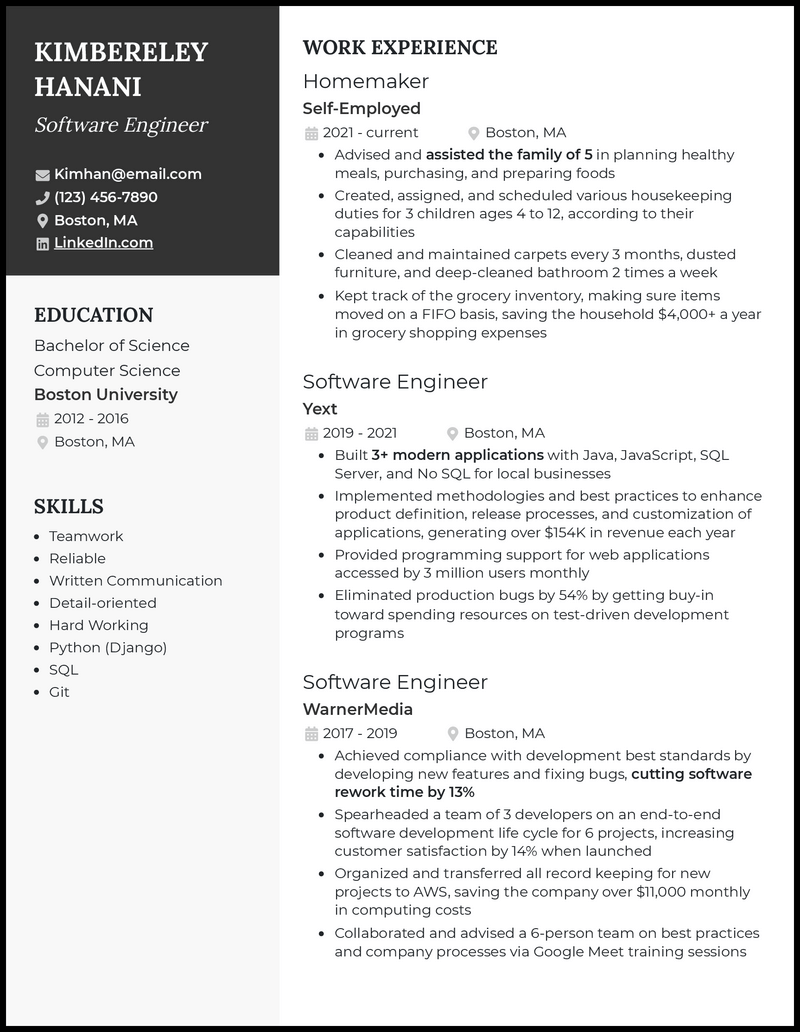
Returning to Workforce





Best for senior and mid-level candidates
Resume Builder
Like this template? Customize this resume and make it your own with the help of our Al-powered suggestions, accent colors, and modern fonts.
Getting back into the workforce can feel overwhelming, but the right returning to workforce resume can help you make a confident and professional return.
This guide will walk you through the best practices for rejoining the workforce and tools like a resume maker and a free AI cover letter builder to help you tell your story with strength and clarity.
What you’ll learn:
- ↪ Five resume examples tailored for returning professionals in different industries
- ↪ How to shift your resume formatting to highlight strengths—not employment gaps
- ↪ Practical ways to position yourself as a strong candidate and get hired faster
Why this resume works
- The last thing you want is to make a bad visual impression after making your grand return. So, make sure that your returning to workforce resume impresses employers visually.
- You don’t need to search for trendy ideas all over the internet either. Our in-house Elegant template will be all you need.
How to Write a Returning to Workforce Resume

Taking a break from your career doesn’t erase the value of your experience. Instead, it’s a fresh professional reset button to reframe your background, presenting your old and new strengths in a way that fits where you’re headed next.
Summary
Reclaim your professional story by showcasing how your past experience, newly gained skills, and time away all contribute to the value you bring today. Focus on clarity, relevance, and confidence to create a resume that positions you for what’s next—not where you left off.
A well-crafted returning to workforce resume can help you bridge that gap—clearly, confidently, and honestly.
Key strategies to focus on:
- Use a flexible format. Consider a combination or functional resume to draw attention to your skills and minimize focus on employment gaps.
- Highlight transferable skills. Think about how your previous roles—and what you learned during your break—translate into the job you want now.
- Show impact in past roles. Instead of just listing responsibilities, point to results. Use numbers when you can.
- Include relevant activities from your break. Volunteer work, part-time roles, certifications, and online courses all count. These show initiative and growth.
- Stay honest. Don’t try to hide the break—explain it briefly if needed, then focus the rest of your resume on what you bring to the table today.

Retouch your contact information section
Your resume’s contact information is the first thing a recruiter sees—so make it clean, current, and professional. Use a professional email (avoid anything quirky or outdated), and include your phone number, LinkedIn profile, and city/state.
Skip full addresses; they’re no longer necessary. Double-check every detail—this is not the place for a typo.

Use the right format
How you organize the content on your resume can influence how your career break is perceived. For many returning professionals, a combination format works best. It brings your skills and achievements to the forefront, placing less emphasis on the timeline.
This is your chance to highlight strengths without letting gaps steal focus. It would be more effective to use a headline generator to create an eye-catching resume title that sets the tone right away.

Convince recruiters to hire you with a powerful career objective
A thoughtful career objective can turn hesitation into interest. In 2–3 crisp lines, explain what you’re aiming for, what you bring, and why you’re the right fit now.
This is your opening pitch—not your full history. Keep it forward-looking and authentic. If you’re unsure how it reads, get feedback using a resume review tool to strengthen it further.
Example
Motivated and detail-oriented professional returning to the workforce after a planned career break, seeking an Operations Coordinator role at Delta Air Lines. Eager to leverage 8+ years of logistics and team leadership experience to drive efficiency, support cross-functional teams, and contribute to Delta’s reputation for excellence.

Address the career gap honestly
Don’t dance around your time away—own it with confidence. Whether it was for parenting, caregiving, illness, or personal growth, a brief explanation paired with what you learned or did during that time (volunteering, courses, freelance work) can demonstrate maturity and resilience. The goal isn’t to explain why you left, but to show who you’ve become since.

Align your transferrable skills to what the job demands
While the role you’re applying for matters, hiring recruiters looking at a returning to workforce resume will want to know whether you applied yourself during your time away.
You don’t have to disclose every sordid detail—all you need is to demonstrate that your skills are relevant to the job, whether new or existing.
Here are some of the best returning to workforce skills recruiters are looking for.
9 best returning to workforce skills
- Customer service
- Project management
- Organization
- Time management
- Problem-solving
- Microsoft Office
- Communication skills
- Active listening
- Patience

Share your best performance from relevant work experiences
Filling in the blanks with any volunteer, freelance, unpaid, or part-time work you might have done will help dispel any assumptions made about your resume gap.
Although you shouldn’t feel like you have to go into specifics about your career break (especially if it’s sensitive or personal), adding quantifiable metrics whenever possible can help potential employers get a better idea of what you did with your time.
Here are a few samples:
- Advised and assisted the family of 5 in planning healthy meals, purchasing, and preparing foods
- Created, assigned, and scheduled various housekeeping duties for 3 children ages 4 to 12, according to their capabilities
- Kept track of the grocery inventory, making sure items moved on a FIFO basis, saving the household $4,000+ a year in grocery shopping expenses
- Provided 24/7 in-home care for my mother during treatment for a medical condition until she made a full recovery within two years
- Traveled to 8 cities in Asia, Australia, South America, and North America to gain personal and professional perspective

Use active verbs to clearly present your value
Action verbs breathe life into your achievements. Use power words such as led, organized, resolved, or revamped to begin every bullet point and set the perfect tone of your capabilities.
This language frames you as a doer, not a bystander. Avoid passive phrases like “responsible for” and instead show what you actually accomplished. Quantify when possible.

Tailor your resume to the job, company, and industry
Generic resumes get ignored. Research the company, study the job posting, and customize your resume for each application. Use keywords naturally, echo the language of the job listing, and emphasize what’s most relevant to that role.
Tools like a job tracker can help you organize your applications and tailor faster.

Proofread before sending
Typos are your enemies and can cost you the job. Read it out loud. Ask a friend to review it. Use grammar tools, but don’t rely on them blindly—human eyes catch tone and nuance that bots miss. This final step signals care, professionalism, and pride in your work.
Top 5 tips for your returning to workforce resume
- Keep your resume to one page
- If you’re returning to the workforce, chances are that the career experience you had might not be as relevant to the current job market, even if you have more than 10 years of experience. Unless you have been actively keeping up with your skills while you were away, it’s better to keep only the important details in your resume.
- List your work experience in reverse-chronological order
- Start with your career break, then record your most recent jobs. This filters out any employers who might prefer complete career histories and addresses your resume gap early on, allowing the reader to focus on the rest of your work experience and what you can contribute to the new role.
- Update your contact information
- You might have moved or had a change in relationship status, leading to a different last name. List your most recent contact details at the top of your resume, and consider adding any career-related social media you might have.
- Consider expanding on your skills and moving them upwards
- Depending on the position you’re applying to, you could benefit from a skills section that details how you applied your skills in a quantifiable and measurable way. You can also highlight your skills section by moving them so that the recruiter reads it before your work experience.
- Change the specific dates in your work experience to years
- Listing your work experience in months and years can make the gap in your career stand out. Changing to using years only will help recruiters focus on the time you spent employed, shifting their perspective toward your career instead of the lack thereof.

Key takeaways
- Keep contact details clean, current, and professional
- Choose a resume format that minimizes attention to gaps
- Write a forward-looking objective that sells your strengths
- Address your break with honesty and confidence
- Use active, impact-driven verbs in bullet points
- Tailor each resume for the specific role and company
- Proofread carefully—details matter
Returning to Workforce Resume FAQs

Your resume should focus on transferable skills, recent certifications or training, and any relevant experience—even unpaid or volunteer work—that showcases your abilities. Be sure to include a short, clear objective, use a format that plays to your strengths, and be transparent about the gap without dwelling on it.
Yes, especially if you’re having trouble filling out the blank space in your resume. You can also link your education with any studying or application you did during your time off. The key here is to demonstrate how your skills and experience are relevant to the present job climate.
Any job will do as long as you’re qualified for it and it appeals to you! Some people choose to change career paths when they return, while others get right back to the industry they previously worked in. While you’re job hunting, consider getting an entry-level job in the meantime to fill out your resume.
While we don’t usually recommend including a career summary if you have a lot of relevant information to include in your resume, adding one can help break the ice and mention your resume gap within the context of your career. If you choose to write one, make sure it’s tailored to the job you’re applying for.
Most recruiters are open to candidates returning after a break—as long as your resume shows clear value. They look for motivation, skills, and alignment with the job more than a flawless work history. A tailored, confident resume often matters more than continuous experience.













